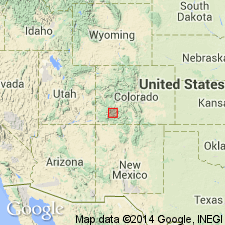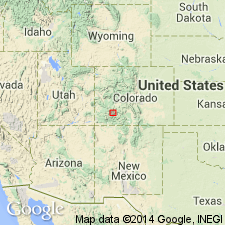
- Usage in publication:
-
- Picayune andesite*
- Modifications:
-
- Original reference
- Dominant lithology:
-
- Andesite
- AAPG geologic province:
-
- San Juan Mountains province
Summary:
Picayune andesite of Silverton volcanic series. Augite andesite in tuff, breccia, or agglomerate, and massive flows; pronounced porphyritic texture. Thicknesa 0 to 500+ feet. Is basal division of Silverton volcanic series. Unconformably underlies Eureka rhyolite and unconformably overlies San Juan tuff. [Age is late Tertiary (Miocene).]
Source: US geologic names lexicon (USGS Bull. 896, p. 1652).

- Usage in publication:
-
- Picayune volcanic group*
- Modifications:
-
- Revised
- Dominant lithology:
-
- Andesite
- Dacite
- Rhyolite
- AAPG geologic province:
-
- San Juan Mountains province
Summary:
Pg. 20, 24-26. Picayune volcanic group. The earliest of lavas of Silverton volcanic series is a dark augite andesite occurring in relatively small exposures in Animas Valley and its minor tributary, Picayune Gulch, and named in Silverton folio the Picayune andesite, after latter locality. It is now known that andesite of Picayune Gulch is but one of the rock varieties erupted in first part of Silverton time, and that the complex group of early lavas is most prominent in country between Henson Creek and head of Lake Fork and in valleys of these streams. The name Picayune will be retained for the group, since it is already in use, and since relations of these rocks to overlying Eureka rhyolite are well shown in original locality. The Picayune volcanic group consists largely of andesite of type first observed, but includes also several kinds of more siliceous lava. The various elements are so irregularly associated as to make it clear the exposed rocks of the group belong to a central volcanic mass made up of surface lava streams, pyroclastic breccia and tuff, and intrusive bodies. The massive rocks have in many places been shattered and dislocated by volcanic shocks. [Age is Tertiary (Miocene).]
Source: US geologic names lexicon (USGS Bull. 896, p. 1652).

- Usage in publication:
-
- Picayune Formation*
- Modifications:
-
- Redescribed
- Dominant lithology:
-
- Breccia
- Tuff
- AAPG geologic province:
-
- San Juan Mountains province
Summary:
Redescribed from Picayune Quartz Latite to Picayune Formation. Is a heterogeneous sequence of thin to thick flows, breccias, and tuffs that range in composition from basaltic andesite to rhyolite. Is thickest (about 2,000 ft) near Lake City. Is the basal formation of Silverton Volcanic Group (formerly called Silverton Volcanic Series). Overlies San Juan Formation (formerly called San Juan Tuff); underlies Eureka Tuff (formerly Eureka Rhyolite). Assigned a middle and late Tertiary age in the San Juan volcanic depression, CO, in the San Juan Mountain province.
Source: GNU records (USGS DDS-6; Denver GNULEX).

- Usage in publication:
-
- Picayune Formation*
- Modifications:
-
- Revised
- AAPG geologic province:
-
- San Juan Mountains province
Summary:
Removed from Silverton Volcanic Group (a term abandoned) in San Juan Mountain province. Picayune lavas are downfaulted vent-facies accumulations forming cores of early volcanoes that were sources of mudflow breccias in San Juan Formation. Is equivalent to Lake Fork Formation (also a vent facies). Assigned an early Oligocene age.
Source: GNU records (USGS DDS-6; Denver GNULEX).

- Usage in publication:
-
- Picayune Megabreccia Member*
- Modifications:
-
- Revised
- Redescribed
- AAPG geologic province:
-
- San Juan Mountains province
Summary:
Rank reduced and assigned to lower part of Sapinero Mesa Tuff. Redescribed as chaotic megabreccia intricately inter-mixed with variable amounts of ash-flow matrix indistinguishable from overlying Eureka Member of Sapinero Mesa with which it interfingers. Unit occurs deep within San Juan caldera and within Uncompahgre caldera, both in San Juan volcanic field, southwest CO, San Juan Mountain province. Dominant rock type of megabreccia is porphyritic andesite containing 10-25 percent phenocrysts of blocky plagioclase and pyroxene associated with local masses of crudely bedded volcanic sandstone and shale. Also contains minor pyroclastic material. Greatest areal exposure in San Juan caldera at Picayune Gulch and farther northeast in American Basin. Figures 7 and 10, respectively, show occurrence on northeast side of San Juan caldera and within Uncompahgre caldera. Overlies Precambrian rocks in San Juan caldera and precaldera volcanic rocks in Uncompahgre caldera. About 28 m.y. old (Oligocene).
Source: GNU records (USGS DDS-6; Denver GNULEX).
For more information, please contact Nancy Stamm, Geologic Names Committee Secretary.
Asterisk (*) indicates published by U.S. Geological Survey authors.
"No current usage" (†) implies that a name has been abandoned or has fallen into disuse. Former usage and, if known, replacement name given in parentheses ( ).
Slash (/) indicates name conflicts with nomenclatural guidelines (CSN, 1933; ACSN, 1961, 1970; NACSN, 1983, 2005, 2021). May be explained within brackets ([ ]).

